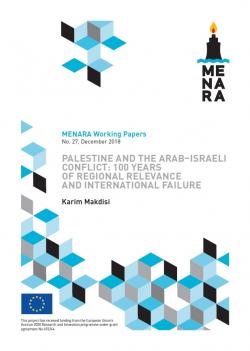Palestine and the Arab–Israeli Conflict: 100 Years of Regional Relevance and International Failure
This paper asserts that the Arab–Israeli conflict, and in particular the question of Palestine, has been the major issue of regional concern across the Middle East for over a century. It claims that the failure to resolve the question of Palestine will continue to impact on the region’s stability and its geopolitical dynamics and to shape popular opinion while limiting Arab leaders’ options. It first situates the Arab–Israeli conflict as a core regional issue in historical context – which is crucial for understanding where we are today – before critically reviewing the Oslo “peace process” and its failure to deliver a just and sustainable peace within the framework of a “two-state solution”. It suggests that this failure has resulted in the ramping up of lingering regional problems (e.g. southern Lebanon, the Golan Heights, refugees and in Palestine itself) and the rise of new challenges and frameworks (e.g. the Resistance Axis and the BDS movement). It concludes that the time has come for the international community – including the European Union, which has contributed to the failure of the two-state solution – to consider alternative paradigms and actions.
-
Details
Rome, IAI, December 2018, 24 p. -
In:
-
Issue
Working Papers 27
Introduction
1. Historicizing the Question of Palestine and the Arab–Israeli Conflict as a Core Regional Issue for a Century
1.1 Zionism and the Origins of the Palestine Question
1.2 Partition of Palestine and the Arab–Israeli Conflict
2. The “Peace Process”: The Rise and Demise of the Two-State Solution
2.1 From the Intifada to the Oslo “Peace Process” and the “Roadmap”: the Two-State Solution Paradigm
2.2 Failure of the “Peace Process” and Demise of the Two-State Paradigm
3. Regional Consequences of the Arab–Israeli Conflict
3.1 Southern Lebanon: Key Active Battleground of the Arab–Israeli Conflict
3.2 Golan Heights: Unresolved Tension and Uncertainty Returns
3.3 Palestine Refugees: Neglected Regional Problem
3.4 Weapons of Mass Destruction in the Middle East: Regional Insecurity
Conclusion
References



